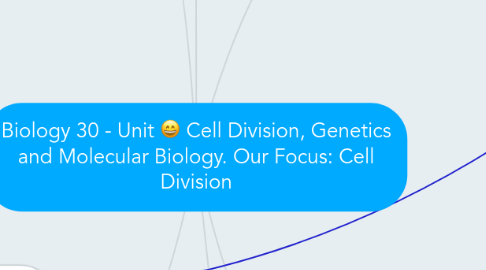
1. Generic Events in Cell Division: PMAT
1.1. Students often associate DNA with organism complexity.
1.2. Difficulty understanding what a "locus" is.
1.3. Often unclear of the differences and similarities between plant and animal cells.
1.4. This is the key concept that a student needs to understand in order to fully understand the other concepts of this topic
2. References
2.1. Common Misconceptions
2.1.1. Williams M, DeBarger A, Montgomery B, Zhou X, Tate E. Exploring middle school students' conceptions of the relationship between genetic inheritance and cell division. Science Education. January 2012;96(1):78-103. Available from: Education Research Complete, Ipswich, MA. Accessed January 11, 2014.
2.1.2. Lewis, J., Leach, J., & Wood-Robinson, C. (2000). Chromosomes: The missing link - young people's understanding of mitosis, meiosis, and fertilisation. Journal of Biological Education, 34(4), 189-199.
2.1.3. Brown, R. C. (1990). Some misconceptions in meiosis shown by students responding to an advanced level practical examination question in biology. Journal of Biological Education, 24(3), 182-186.
3. Grade 9 Unit A: Biological Diversity
3.1. Inheritance
3.1.1. Natural Selection
3.2. Chromosomes, Genes, and DNA
3.3. Cell Division
3.3.1. Binary Fission
3.3.2. Formation of Sex Cells
3.4. Asexual and Sexual Reproduction
3.5. Important to have a strong understanding of all of these concepts because they are fuondational to Biology 30.
4. Key Concepts in Cell Division
4.1. Process of Meiosis
4.1.1. Difficulty understanding the difference between mitosis and meiosis.
4.2. Process of Mitosis
4.2.1. Challenges associated with understanding that this occurs in all somatic cells.
4.3. Chromosome Number Changes in Sex and Somatic Cells
4.3.1. Difficulty visualizing chromosomes and the changes they undergo.
4.4. Organism Inheritance and Development: roles of nondisjunction and crossing over of chromosomes
4.4.1. Often difficult to visualize the process of "crossing-over" and non-disjunction - especially if information is delivered in lecture-style.
4.4.2. Difficulty understanding that both parents contribute equally.
4.5. Comparison of Fraternal and Maternal Twins
5. Grade 8 is the first time the concept of 'cells' appear: Unit B - Cells and Systems
6. Why are these concepts in Biology 30 important?
6.1. Post-Secondary Requirements
6.1.1. Many Programs of Study in post-secondary Institutions require basic understanding of cellular biology which includes cellular division. Examples of these programs are:
6.1.1.1. Biochemistry
6.1.1.2. Dentistry
6.1.1.3. Dental Hygiene
6.1.1.4. Ecology
6.1.1.5. Medicine
6.1.1.6. Nursing
6.1.1.7. Pharmacy
6.1.1.8. Health Research and Drug Design
6.1.1.9. Any program with a major or minor in biology
6.1.1.9.1. Such as teaching!
6.1.1.10. Technician Diploma or Certificate in Health Related Field
6.1.1.11. Any program that has biology as pre-requisite
6.2. Real world implication of this topic: cellular biology tries to explain and help students understand what we are made of and how the inner workings of how multicellular organisms operate. Some examples of cell biology and, more specifically, cellular division that occurs in life are:
6.2.1. Reproductive Therapy
6.2.1.1. In vitro fertilization
6.2.1.2. Artficial Insemination
6.2.1.3. Cloning
6.2.2. Embryology
6.2.2.1. Evolutionary steps in the development of a fetus
6.2.2.2. Cell specialization in order to develop the fetus
6.2.2.3. Complications that occur during the growth of a fetus, such as chromosomal abnormalities, mutations, loss of cells, teratogen affects on the fetus and other non-specific birth defects
6.2.2.3.1. For example: how down syndrome, haemophilia, or cystic fibrosis
6.2.2.4. Development and cause of twins
6.2.3. Treatment of Disease
6.2.3.1. Cancer therapy
6.2.3.2. Prevention or regression of aging process
6.2.3.2.1. How to stop or slow down?
6.2.3.3. Gene therapy
6.2.3.3.1. Somatic cell gene therapy
6.2.3.3.2. Germ cell gene therapy
6.2.3.4. Viral therapy
6.2.3.4.1. Development of anti-virals and other medication
6.2.3.4.2. Use of virus' for the treatment of other diseases
